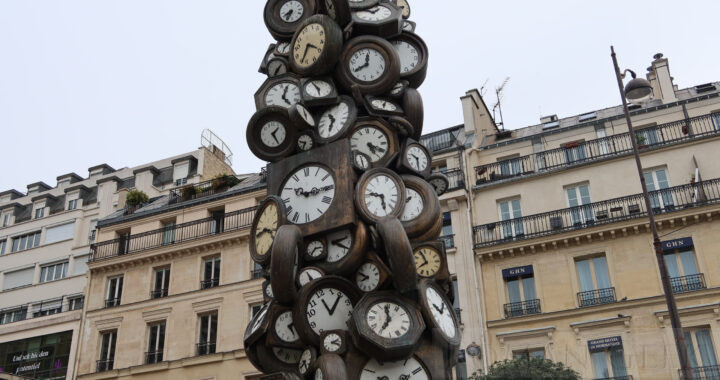- The Romans kept time by using sundials during the day and waterclocks during the night.
- Roman Time was measured by the hour, not by the minute. There were 24 hours in a day, divided into 12 hours of day and 12 hours of night. measured from sunrise to sunset.
Measuring Time Today
- Today the day is divided into 24 hours, each hour having 60 minutes, each minute having 60 seconds.
- We either use the 24 hour clock starting from Midnight, or we divide the day into 12 hours before Noon and 12 hours after Noon. Noon is Meridiem in Latin.
- 6 o’clock in the morning becomes 6 AM, ‘Six Ante Meridiem’, meaning before Noon.
- And 6 o’clock in the evening becomes 6 PM ‘Six Post Meridiem’ meaning after Noon.
- We then divide the hours into halves and quarters, as in ‘a quarter past 6’ or ‘half past 6’.
Measuring Time in the Roman Period
- Roman Time was only measured by the hour, not in minutes and seconds as today.
- There were 24 hours in a day, divided into 12 hours of day and 12 hours of night.
- But unlike today, the 12 hours of day were measured from sunrise to sunset, so they did not always have 60 minutes.
- The length of the hour during the day was only 45 minutes at the winter solstice, but would be 75 minutes at the summer solstice.
- The Romans understood that the length of the day varied according to the season, and also according to the latitude.
Naming the divisions of the Roman Civil Day
- The Romans started their day from midnight to midnight.
- The day was divided into 16 parts:
- Media nox (midnight)
- Mediae noctis inclinatio (after midnight)
- Gallicinium (cock crow)
- Conticinium (cock stops crowing)
- Diluculum (dawn)
- Mane (morning)
- Antemeridianum tempus (before noon)
- Meridies (Noon)
- Tempus pomeridianum (after noon)
- Solis occasus (sunset)
- Vespera (evening)
- Crespusculum (twilight)
- Prima fax (candle lighting)
- Concubia nox (bedtime)
- Intempesta nox (late in the night)
- Inclinatio ad mediam noctem (before midnight)
Numbering the 24 Hours of the Roman Day (I, II, III, etc)
- The Roman day started at sunrise and ended at sunset, and was divided into 12 hours using either sundials or waterclocks.
- The hours were numbered ‘hora prima, hora secunda, hora tertia’, and so on.
- ‘Prima diei hora’ meant first hour of the day.
- The hours of the Roman night were numbered ‘Prima noctis hora, secunda noctis hora’, etc.
- ‘Prima noctis hora’ meant first hour of the night.
The Four Watches of the Roman Night
- The Roman night, was also of 12 hours, and was divided into 4 watches (vigilae) of three hours each, using water clocks. Night started at sunset and finished at sunrise.
- Prima vigila (first watch of the night) The watch after sunset.
- Secunda vigilia (second watch of the night) The watch before midnight.
- Tertia vigilia (third watch of the night) The watch after midnight)
- Quarta vigilia (fourth watch of the night) The watch before dawn)
Roman Army
- No description has survived of the method used to record time, except for a few inscriptions.
- However, we know the Army followed a routine of Wake up Calls, Meals, Marching and Sleeping, which were fixed at predefined hours of the day.
- The Night Watch (Vigiliae) was divided into 4 sections of 3 hours, using a waterclock or Klepsydra.
- Ostraka from the small Fort at Crocodilos, Egypt, reveal a daily log recording the arrival and departure times of the soldiers and messengers. So even mundane chores were timed.
- It would appear that there was a clock in every legionary fort. The army official responsible for maintaining time was called the Horologiarius.
Roman Water Clock
- The Romans used a Clepsydra or water clock to give the hours of the day.
Roman Sundial
- Roman Sundial was divided into Hours using either a semicircular dial or a concave hemispherical surface with a nodus that measured the sun’s shadow.
Roman Calendar
- Roman Calendar (753 BCE)
- The Calendar started with the foundation of Rome in 793 BCE, as 10 months of 304 days. Later, 2 months were added to make it 12 months.
- Julian Calendar (45 BCE)
- After the reforms of Julius Caesar in 46 BCE, it consisted of 12 months of 365 days with an extra day every four years, as it is today.
The Eight day week (Nundinae)
- The early Roman Calendar included an eight day cycle. Nundinae meaning nine in latin, which refers to the ninth day which was a market day. The ninth day was effectively the first day of the new week of eight days.
- As the ninth day fell on a different day on each cycle, they were marked on calendar lists called fasti, using nundinal letters from A to H. In the early 304 day calendar, there were 38 Nundinae cycles.
Image above: Clock Sculpture, Gare Saint Lazare, Paris

